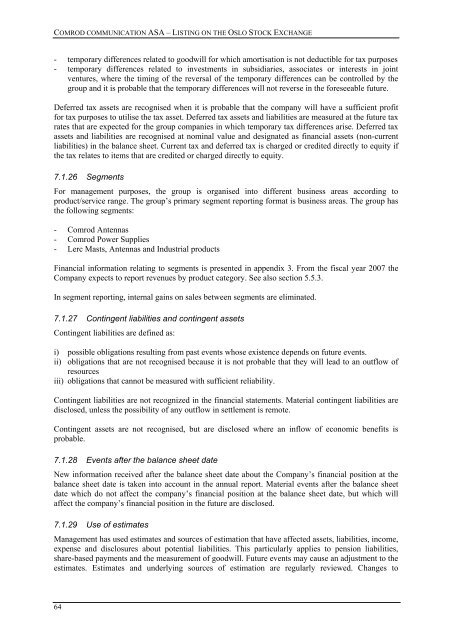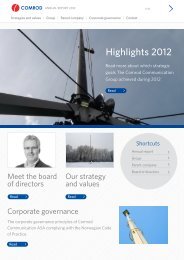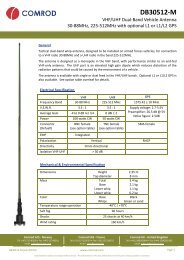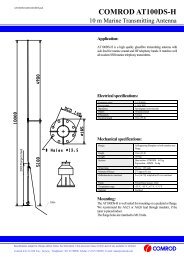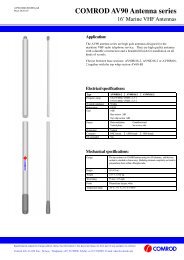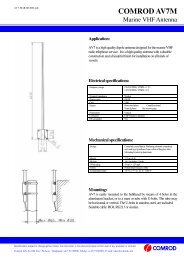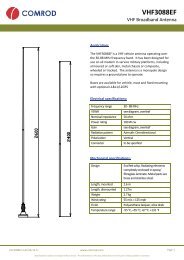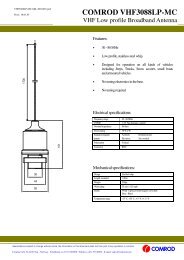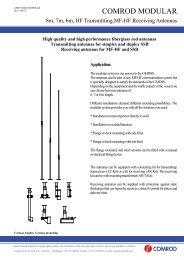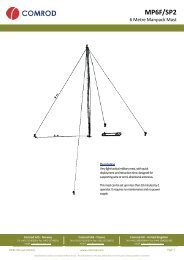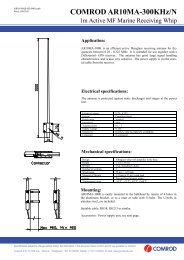English version - Hexagon Composites ASA
English version - Hexagon Composites ASA
English version - Hexagon Composites ASA
You also want an ePaper? Increase the reach of your titles
YUMPU automatically turns print PDFs into web optimized ePapers that Google loves.
COMROD COMMUNICATION <strong>ASA</strong> – LISTING ON THE OSLO STOCK EXCHANGE<br />
- temporary differences related to goodwill for which amortisation is not deductible for tax purposes<br />
- temporary differences related to investments in subsidiaries, associates or interests in joint<br />
ventures, where the timing of the reversal of the temporary differences can be controlled by the<br />
group and it is probable that the temporary differences will not reverse in the foreseeable future.<br />
Deferred tax assets are recognised when it is probable that the company will have a sufficient profit<br />
for tax purposes to utilise the tax asset. Deferred tax assets and liabilities are measured at the future tax<br />
rates that are expected for the group companies in which temporary tax differences arise. Deferred tax<br />
assets and liabilities are recognised at nominal value and designated as financial assets (non-current<br />
liabilities) in the balance sheet. Current tax and deferred tax is charged or credited directly to equity if<br />
the tax relates to items that are credited or charged directly to equity.<br />
7.1.26 Segments<br />
For management purposes, the group is organised into different business areas according to<br />
product/service range. The group’s primary segment reporting format is business areas. The group has<br />
the following segments:<br />
- Comrod Antennas<br />
- Comrod Power Supplies<br />
- Lerc Masts, Antennas and Industrial products<br />
Financial information relating to segments is presented in appendix 3. From the fiscal year 2007 the<br />
Company expects to report revenues by product category. See also section 5.5.3.<br />
In segment reporting, internal gains on sales between segments are eliminated.<br />
7.1.27 Contingent liabilities and contingent assets<br />
Contingent liabilities are defined as:<br />
i) possible obligations resulting from past events whose existence depends on future events.<br />
ii) obligations that are not recognised because it is not probable that they will lead to an outflow of<br />
resources<br />
iii) obligations that cannot be measured with sufficient reliability.<br />
Contingent liabilities are not recognized in the financial statements. Material contingent liabilities are<br />
disclosed, unless the possibility of any outflow in settlement is remote.<br />
Contingent assets are not recognised, but are disclosed where an inflow of economic benefits is<br />
probable.<br />
7.1.28 Events after the balance sheet date<br />
New information received after the balance sheet date about the Company’s financial position at the<br />
balance sheet date is taken into account in the annual report. Material events after the balance sheet<br />
date which do not affect the company’s financial position at the balance sheet date, but which will<br />
affect the company’s financial position in the future are disclosed.<br />
7.1.29 Use of estimates<br />
Management has used estimates and sources of estimation that have affected assets, liabilities, income,<br />
expense and disclosures about potential liabilities. This particularly applies to pension liabilities,<br />
share-based payments and the measurement of goodwill. Future events may cause an adjustment to the<br />
estimates. Estimates and underlying sources of estimation are regularly reviewed. Changes to<br />
64


